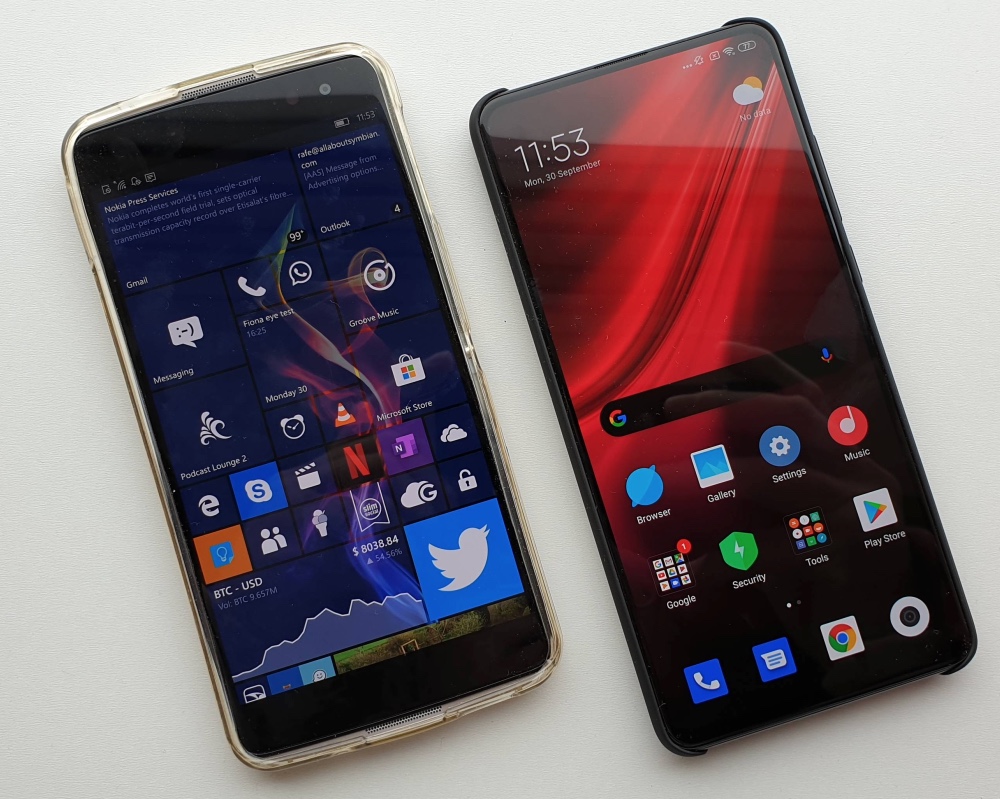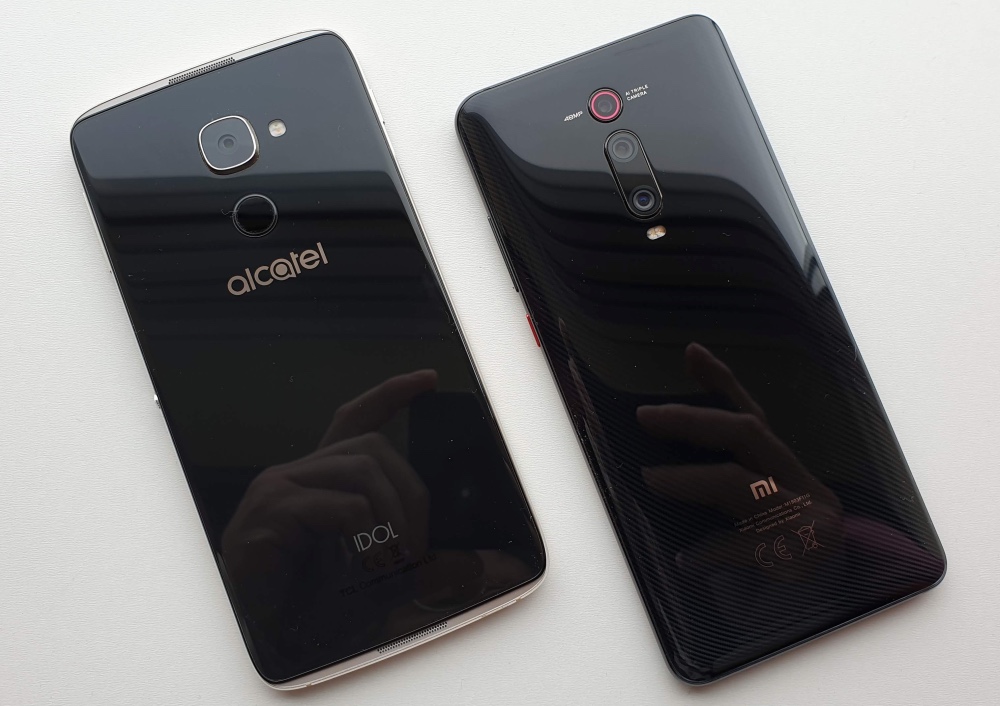
As usual, I've shaded in green an obvious 'win' for either device, I honestly have no idea which way this one's going to go (as I start to compile the feature)... Any row where a winner would be totally subjective is left uncoloured. Or, where both devices are utterly excellent but in different ways, I've given both a 'green'(!)
| Alcatel IDOL 4 Pro | Xiaomi Mi 9T Pro | |
| Date first available | August 2017 | August 2019 |
| Current price, availability | No longer available officially, see clearance bins around the world, or second hand. Suggested price £150 or local equivalent? | £350, SIM-free, inc VAT, for the 128GB/6GB version here (a 64GB, and 256GB/8GB RAM version is also available) |
| Dimensions, form factor, weight, design |
154 x 75 x 7mm, aluminium frame with toughened glass front and back, 152g |
157 x 74 x 9mm, aluminium chassis, toughened glass front and back, 191g, thicker and heavier (good because it allows more battery) |
| Durability | No specific durability metrics, plus the dual sided glass design means a case is a must. If water gets in then you're pretty much out of luck. Sadly. |
No specific durability metrics, so again a case is a must - and lovely rubberised case is included in the box, a nice touch. |
| Operating system, interface | Windows 10 Mobile (now running Fall Creators Update), (dismissable) virtual controls. |
Android 9.0, MIUI 10, swipe controls, full screen all the time. |
| Display | Samsung-made 5.5" AMOLED 1080p panel, Dragontrail Glass, excellent colour balance, contrast and viewing angles. Screen area is approximately 84 cm2 |
6.4" AMOLED 1080p screen, Gorilla Glass 5, very similar contrast and colours to the IDOL 4 Pro. Screen area is larger, at approximately 100cm2, thanks to smaller bezels, so gets a win here for having more room for content, all other things being equal. |
| Connectivity | LTE, Wi-Fi b/g/n/ac, integral wifi tethering, Bluetooth 4.1, Continuum connectivity to use external displays as secondary screen, independent of the phone display. Note that - perhaps significantly - there's no NFC! | LTE, NFC (all uses), Wi-Fi b/g/n/ac, integral wifi tethering, Bluetooth 5.0 (all uses). [Can't pick a winner here, since NFC and Continuum cancel each out at one 'Pro' each!] |
| Processor, performance | Snapdragon 820 chipset, 4GB RAM (of which 3.5GB are used directly), the fastest Windows phone I've tested so far, despite the lack of TLC from Microsoft or Alcatel in terms of tuning | Snapdragon 855 with 6GB RAM (on the variant here). Very fast at everything compared to the Windows 10 phone. |
| Capacity | 64GB, expandable via microSD to 256GB or for card swapping | 128GB internal storage (in the variant being considered), no expansion |
| Imaging (stills) |
21MP f/2.2 1/2.4" BSI sensor, dual LED flash, HDR shots, PDAF, very decent shots in most light conditions, but capture is relatively slow and it all falls down in really low light, as you'd expect (with no OIS). See my review part 2. 8MP front camera |
Cameras: 48 MP, f/1.8, 1/2", PDAF, Laser AF Decent results, though see my upcoming pitch on AAWP against the Lumia 950 XL, where it will struggle slightly, I predict! Motorised 20MP front camera, f/2.2 |
| Imaging (video) | 4K, optionally digitally stabilised (EIS), with 'Best photo' 8MP grabbing built-in, plus high amplitude stereo audio recording. See my review part 3. | Up to 4K video capture, with excellent stabilisation at all resolutions and with good stereo audio capture. |
| Music (headphones) | 3.5mm headphone jack, driven by a power amp and pro-quality DAC. Absolutely stunning volume and fidelity. | 3.5mm headphone jack, but the DAC (probably the one in the main chipset) is not in the same league as the dedicated power amp in the IDOL 4 Pro here. |
| Music (speakers) | Terrific front-facing 3.6W stereo speakers, not quite the best in the world still, but right up there with the best in terms of volume. | Mono speaker, a bit tinny. Loud enough for sat nav and speakerphone calls, but avoid music or movies. |
| Navigation | Windows 10 Maps is comprehensive, has a degree of live traffic awareness (see the latest workaround), Includes full offline maps with automatic updates. |
Google Maps is now the gold standard in phone navigation, tied in with many other Google services and offering true real time navigation around traffic issues. |
| Cortana/Voice | Cortana is now mature and well integrated, and with a surprising degree of 'assistance'. | Google Assistant is baked in and works well (activated from the lockscreen or via voice), arguably superior to Cortana in 2019, due to the investment that Google has put in over the last few years. |
| Battery, life | Sealed 3000mAh battery, just about gets through a day even with Windows 10 Mobile(!), plus USB Type C fast charging (up to 2A) and compatibility with Qualcomm's Quickcharge 3.0 (up to 18W). No Qi wireless charging. | Sealed 4000mAh battery, easily gets through a day. Charging is up to 27W through the USB Type C port with QuickCharge 4.0. No Qi wireless charging. |
| Cloud aids | Windows Photos runs at full resolution and quality, and syncs across all signed-in devices, subject to your OneDrive tariff, should you have thousands of images in the system. Plus Windows 10 backs all your media, application data and settings to a separate backup folder system, tariff-free on OneDrive. | Google Photos does a great job of organising photos and syncing them across all signed-in phones and tablets, albeit at 'reduced' quality (re-compression server-side). |
| File compatibility | As with all Windows phones, plugging into a Windows PC gives full drag and drop to the phone's user file system. Plugging into a Mac sadly isn't possible anymore. | Plugging into a PC gives immediate MTP file access, plus this works well on a Mac with Google's Android File Transfer utility, for drag and drop of all user files. |
| Biometrics | The fingerprint sensor is slower than most in the industry, and it's not clear why! Plus the 'Hello' animation takes a second. On the positive side, it's a lot faster than PIN entry or iris recognition. On the (other) negative side, there's no Microsoft Wallet/Pay. Or NFC. So that side of things is a no go. | The fingerprint sensor is under the screen and works surprisingly well, certainly better than the half-assed capacitive implementation on the Alcatel. So - ironically, again - the best of the optical in-screens is better than the worst of the capacitive! Works well with Google Pay. |
| Applications and ecosystem | Windows 10 Mobile now has just about every mainstream app covered, aside from Snapchat and Tinder. And anything to do with Google services! Most things can be done via Edge, though 'not quite' as slickly as with dedicated applications. | The might of Google and Android's app ecosystem - everything is available and almost always in first party form. |
| Upgrades and future |
Windows 10 Mobile will be updated until the end of 2019, of course, as part of the global Windows 10 ecosystem and the regular patching and fixing process. Production devices can expect updates every month. The future (2020-) is looking a bit bleak though. |
Xiaomi's update record is a little patchy, but I'd still expect monthly security updates through 2020. |

Verdict
Adding up the green 'wins' gives a resounding 11-3 score in favour of the much newer device, of course, though the IDOL 4 Pro still holds up well in many ways, certainly for playing back music and media, for a phone which started life in 2016 (in the USA). The big question is, of course, whether I'd recommend the Xiaomi Mi 9T Pro as an upgrade from an Alcatel or top end Lumia? The price is certainly right, the computing power undisputable, there's a lot to like. As often is the case (especially for AAWP readers), it will probably all come down to how good or bad the camera system is - and that means another feature, comparing the Mi 9T Pro to a Lumia 950 XL. Watch this space!
